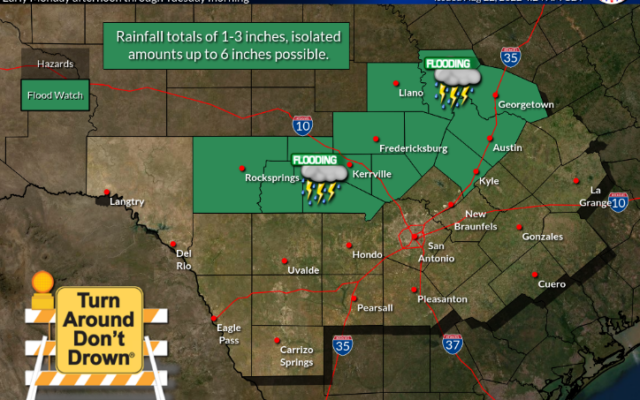NWS Flood Warning: A Comprehensive Safety Guide

Table of Contents
Understanding NWS Flood Warnings and Watches
Knowing the difference between a flood warning, watch, and advisory is the first step to effective flood preparedness. These alerts, disseminated through various channels – weather radio, mobile apps like NOAA Weather Radio, television broadcasts, and the NWS website – utilize the Emergency Alert System (EAS) to reach a wide audience. Understanding their urgency is critical.
- Flood Warning: This means flooding is occurring or is imminent. Take immediate action! This is the most urgent alert.
- Flood Watch: Conditions are favorable for flooding. Remain vigilant and monitor the situation closely. Be prepared to act quickly if a warning is issued.
- Flood Advisory: Flooding is possible, but the threat is less severe than a watch or warning. Remain aware of conditions and be prepared for potential flooding.
It's also important to distinguish these flood alerts from other severe weather warnings, such as severe thunderstorm warnings, which may also contribute to flooding. Pay attention to all weather alerts issued by the NWS.
Preparing for a NWS Flood Warning
Proactive measures are key to minimizing the impact of a flood. Developing a comprehensive flood preparedness plan well in advance is vital.
- Develop a Family Communication Plan: Establish a primary and secondary contact person outside your immediate area and decide on a meeting point in case of separation.
- Assemble an Emergency Kit: Include essentials like water (one gallon per person per day for several days), non-perishable food, a first-aid kit, medications, copies of important documents (insurance, identification), flashlights, batteries, and a NOAA weather radio.
- Identify Safe Evacuation Routes and Meeting Places: Know multiple routes to higher ground and designate safe meeting places both near and far from your home.
- Purchase Flood Insurance: Flood insurance is often not included in standard homeowner's insurance, and it can significantly reduce financial losses in the event of a flood. Check your policy and consider supplemental coverage.
- Take Steps to Flood-Proof Your Home: Elevate electrical systems, install flood barriers, and consider waterproof materials in your basement or ground floor.
Responding to a NWS Flood Warning
When an NWS flood warning is issued, immediate action is critical. Your life and the lives of your loved ones depend on your swift response.
- Evacuate Immediately if Instructed by Authorities: Do not delay; heed evacuation orders without hesitation.
- Move Valuables to Higher Levels: Move essential items, furniture, and electronics to upper floors or higher ground.
- Never Drive or Walk Through Floodwaters: Even a few inches of water can sweep a vehicle off the road, and deeper water can be incredibly dangerous. Remember the crucial phrase, "Turn Around, Don't Drown."
- Stay Informed Through Official Sources: Continuously monitor updates from the NWS, local news, and emergency management agencies.
- Contact Emergency Services if You Need Assistance: If you are trapped or in immediate danger, call your local emergency services immediately.
Recovering After a Flood
Recovering from a flood is a challenging process, but taking the right steps can help you rebuild and minimize long-term damage.
- Contact Your Insurance Company to File a Claim: Document all damage with photos and videos as soon as it is safe to do so.
- Document All Flood Damage with Photos and Videos: This will expedite your insurance claim process.
- Clean and Sanitize Affected Areas Carefully: Be aware of the dangers of contaminated water and use appropriate safety gear during cleanup.
- Be Aware of the Dangers of Mold and Seek Professional Remediation: Mold can cause serious health problems; don't hesitate to seek professional assistance.
- Consider Contacting FEMA or Other Relief Agencies for Assistance: Federal, state, and local agencies may offer aid for flood recovery.
Conclusion
Understanding and preparing for an NWS flood warning is not just about protecting your property; it’s about safeguarding lives. By developing a comprehensive flood preparedness plan, familiarizing yourself with different alert levels, and taking swift action when a warning is issued, you can significantly reduce the risks associated with flooding. Stay safe with your NWS flood warning plan; prepare for an NWS flood warning today. Learn more about NWS flood warnings and be prepared to protect your family and your home.

Featured Posts
-
 Monaco Grand Prix Fp 1 Leclerc Sets The Pace Verstappen Challenges
May 26, 2025
Monaco Grand Prix Fp 1 Leclerc Sets The Pace Verstappen Challenges
May 26, 2025 -
 Andalucian Farmstay Your Perfect Escape From Daily Life
May 26, 2025
Andalucian Farmstay Your Perfect Escape From Daily Life
May 26, 2025 -
 Mercedes New Leader How George Russell Brought Calm And Confidence
May 26, 2025
Mercedes New Leader How George Russell Brought Calm And Confidence
May 26, 2025 -
 2025s Best Nike Running Shoes Expert Recommendations And Comparisons
May 26, 2025
2025s Best Nike Running Shoes Expert Recommendations And Comparisons
May 26, 2025 -
 The Best Nike Running Shoes Of 2025 Style Performance And Reviews
May 26, 2025
The Best Nike Running Shoes Of 2025 Style Performance And Reviews
May 26, 2025
Latest Posts
-
 Will Man United Make A Move For Rayan Cherki This Summer
May 28, 2025
Will Man United Make A Move For Rayan Cherki This Summer
May 28, 2025 -
 Manchester Uniteds Summer Pursuit Of Rayan Cherki
May 28, 2025
Manchester Uniteds Summer Pursuit Of Rayan Cherki
May 28, 2025 -
 Euro Millions Live Record E245m Jackpot Friday Draw
May 28, 2025
Euro Millions Live Record E245m Jackpot Friday Draw
May 28, 2025 -
 Follow The E245m Euro Millions Jackpot Draw Live This Friday
May 28, 2025
Follow The E245m Euro Millions Jackpot Draw Live This Friday
May 28, 2025 -
 Fridays Euro Millions Draw E245 Million Jackpot Live Updates
May 28, 2025
Fridays Euro Millions Draw E245 Million Jackpot Live Updates
May 28, 2025
